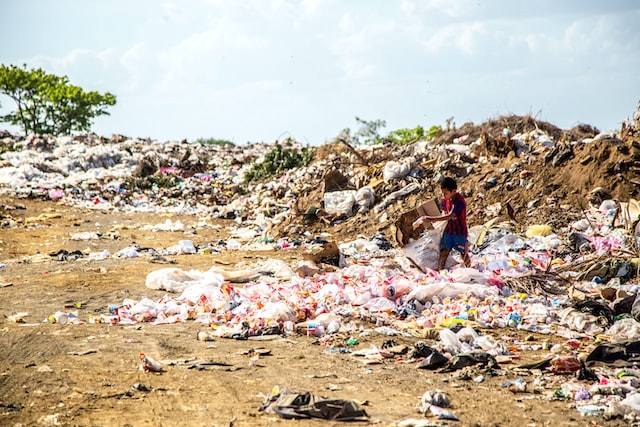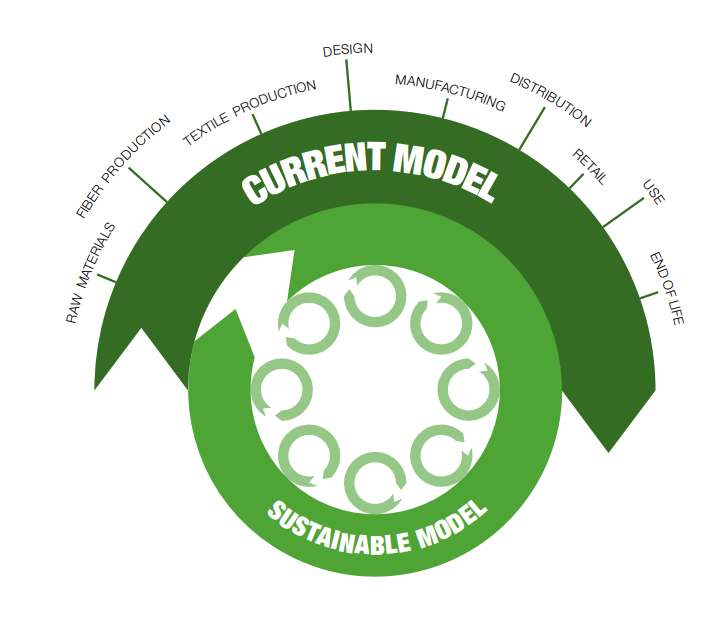Menu
Sustainable fashion refers to clothing and accessories that are produced in a way that’s environmentally friendly, socially responsible, and economically viable. Sustainable fashion is about ensuring that there is no harm done to the people involved in manufacturing our clothes, the environment where they were made, or even how we dispose of them when they wear out. There are three main parameters that determine whether a piece of clothing is sustainable or not: its carbon footprint (how much it contributes to global warming) , its potential for waste after use and the manufacturing practices while making the clothes.

Sustainable fashion is the practice of designing, manufacturing, distributing, and consuming fashion in a way that can be sustained indefinitely (or for a long period of time). While it may seem to be a new approach to the way we think about and make clothes, it has been practiced in, albeit, a different form by earlier civilizations. Read more here (History of Clothing In Indian Subcontinent), and here (Clothing In India)
However, current era Sustainable fashion advocates for conscious consumerism: choosing to purchase products that have less impact on the environment.
The need for sustainable fashion has never been more urgent than it is today. As consumers become more aware of their choices and how they affect our planet, they are demanding more responsible options from brands!
Read more here
Sustainable fashion is important because it helps the environment, people, economy, and future of fashion.
Being accountable for one’s actions and realizing that it is a waste of time and resources to produce something that will not persist or be valuable to others are key components of sustainable fashion. One should only purchase items that have been manufactured with care and attention to detail so they can last for more than one season. Because these items are of high quality, businesses can produce them with fewer resources.
Consider the source of your clothing as well. Are there decent working conditions there? Are they produced domestically or abroad? How far did they travel if they were manufactured abroad before they got to your home or shop? How transparent is the brand? How long do you intend to use the garment and are there any ways to recycled/repurpose the garment after it has served out its useful life. For Sustainable fashion to be adopted more widely, the movement needs to be supported by manufacturers, consumers and the government.

PC: https://unsplash.com/
Sustainable fashion is a response to the growing demand for clothing and accessories that are environmentally, socially, and economically sustainable. It’s about creating a new way of thinking about how we consume clothes, one that takes into consideration our planet’s resources as well as those who make them.
Sustainable fashion is not just about recycling or reducing waste–it’s also about creating products that can be reused over time, through repair or repurposing (like making new garments from old). If you’ve ever bought secondhand clothing at a thrift store or consignment shop, then you’ve already been exposed to this idea! Sustainable brands work with local artisans all around the world who have been making traditional garments for generations; these artisans often use natural dyes which produce less pollution during production than synthetic dyes do.
There are 3 main actors: Fashion Industry, Government, and the Consumers
The fashion industry is responsible for ensuring that sustainable manufacturing practices are followed despite the regulations. Many-a-times, industries are aware of the harmful effects of their practices, even before governments catch a whiff of it.
The Government is responsible for regulating and ensuring policies drive change at the industry level.
The Consumers are responsible for holding the industry accountable to their actions and decisions through their buying power.
No one player can bring about a change single-handedly. However, in our opinion, the industry holds the biggest key here. As a consumer, you also have the power to drive change. The most effective way to do this is by putting your money where your mouth is. When you purchase goods, ask yourself if they are sustainable and whether they will be used again at some point in time. If not, why not? What’s stopping them from being recycled or reused?
Pros:
Sustainable fashion is a way of life that promotes the long-term health of the planet and its inhabitants. It’s also trendy, with many people choosing to shop in this way because they like how sustainable products look or feel.
Sustainable fashion brands tend to be more expensive than conventional ones, but they’re often worth it because you’ll end up spending less money on replacements over time (since they last longer).
Cons:
Some people find organic cotton clothes too stiff or scratchy compared to conventional ones made from synthetic materials such as polyester or nylon; others may simply prefer the feel of non-organic fabrics in their hands when touching them for comfort reasons alone! However, there are plenty of options for those who want something soft against their skin regardless of whether it comes from an animal source (like wool) versus synthetic fibers like rayon made from wood pulp cellulose acetate mixed with acrylic resins such as polyurethane resin
The fashion industry is facing a number of issues that need to be addressed. These include:
Environmental issues. The clothing industry produces 1/3 of the world’s carbon emissions and uses more water than any other manufacturing sector, according to the Ellen MacArthur Foundation.
Social issues. Workers in developing countries often face unsafe working conditions and low wages, which can lead to human rights violations like child labor or forced labor practices.
Economic issues. The cost of producing an item can be higher than what consumers are willing to pay for it; this means that many companies lose money on every product they sell if they want them made sustainably or ethically (therefore making them less likely to adopt this model).
There are many regulations and policies that promote sustainable fashion. The Sustainable Apparel Coalition is a non-profit organization that works to drive the development and implementation of standards for sustainable apparel. India also abides by global standards, such as ISSB Sustainability Disclosure: a global standard for sustainability reporting; EU Taxonomy’s Climate Delegated Act; EU’s Sustainable Finance Disclosure Regulation (SFDR), which requires companies listed on European stock exchanges to disclose their climate risk management practices; CSRD: Europe’s new sustainability reporting directive
Sustainable fashion is the use of materials that are renewable, biodegradable, and recyclable. It also involves using less water in the production process.
Sustainable fashion can help reduce the negative effects of climate change by reducing greenhouse gas emissions, cutting down on waste, improving air quality, and supporting local communities. It can also contribute to a healthier environment by reducing exposure to toxic chemicals such as pesticides used in cotton fields or coal tar used in manufacturing leather goods.
Sustainable fashion is a broad term that encompasses three main areas: environmental, social, and economic. Each of these three core aspects has its own set of criteria for sustainability.
Sustainable fashion is a relatively new concept in the fashion industry. Although it has existed for centuries, it wasn’t until recently that sustainable practices became mainstream within the industry. Over time, sustainable fashion has evolved and changed to be more inclusive of people from different backgrounds and cultures around the world.
The Sustainable Fashion Framework is a useful tool to evaluate the sustainability of fashion products. It’s a framework that helps designers, buyers, and consumers understand how sustainable fashion works. The goal of this framework is to identify ways in which companies can improve their business models so they become more sustainable.
UN Alliance for Sustainable Fashion launched the Sustainable Fashion Framework in 2016 as an effort to help brands make more informed decisions regarding their environmental impact on a global scale. More care be read here (https://unfashionalliance.org/).

Source: https://www.bsr.org/
We believe that sustainable fashion is the future. It offers us a way to reduce our carbon footprint and make a positive impact on our environment. It also helps us live healthier lives by consuming less toxic chemicals in our clothes. But most importantly, it allows us to be more aware of what we buy and where it comes from so that we can make better choices as consumers
Sustainable fashion is a movement that seeks to reduce the environmental impact of the fashion industry. It includes practices such as using eco-friendly materials, reducing waste, and promoting ethical labor practices. Sustainable fashion aims to create a more environmentally and socially responsible industry.
Sustainable fashion is the opposite of fast fashion. Fast fashion refers to the mass production of cheap and trendy clothing, which is often made with low-quality materials and produced in ways that are harmful to the environment and workers. Sustainable fashion, on the other hand, prioritizes ethical and eco-friendly practices and aims to create long-lasting, high-quality clothing that is produced in a responsible manner.
There are several ways to support sustainable fashion, including buying clothing from sustainable brands, shopping secondhand, upcycling and repairing clothing, and donating or recycling unwanted items. Additionally, supporting legislation and policies that promote sustainability in the fashion industry can help drive change.
Sustainable fashion can be more expensive than fast fashion, but it doesn’t have to be. While some sustainable brands may have higher price points, there are many affordable sustainable options available. Additionally, investing in high-quality, long-lasting pieces can save money in the long run by reducing the need for frequent replacements.
Sustainable fashion is important because the fashion industry has a significant impact on the environment and workers. The production of clothing uses large amounts of resources and creates pollution, and many workers in the industry are underpaid and subjected to poor working conditions. By promoting sustainable practices, the fashion industry can reduce its negative impact and create a more responsible and ethical industry.
Get 60% Off on Kids & Women's Tees! Dismiss